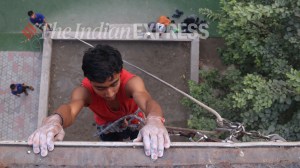Archaeologist refuses to revise Keeladi report, writes back to ASI quoting excavation’s integrity
“The tone of Ramakrishna’s reply is notably formal, but his words make clear he sees the ASI’s intervention as redundant and unnecessary,” said a source known to the letter’s content.
 The ASI’s original letter, dated May 15, had asked for a reassessment of the site’s chronological brackets, particularly the proposed 8th century BCE dating. (File photo)
The ASI’s original letter, dated May 15, had asked for a reassessment of the site’s chronological brackets, particularly the proposed 8th century BCE dating. (File photo)Amid renewed scrutiny from the Archaeological Survey of India (ASI), archaeologist K Amarnath Ramakrishna has written a strongly worded letter, refusing to revise his final report on the Keeladi excavations. The letter, sent to ASI’s Director (Exploration and Excavation) Hemasagar A Naik, defends the findings and methodology employed in documenting one of Tamil Nadu’s most consequential archaeological sites.
More than two years after Ramakrishna submitted his 982-page final report in January 2023—after previous preliminary and interim submissions in 2016 and 2017, respectively—the ASI had written to him on May 23, 2025, asking for corrections to “make the report more authentic”. In response, Ramakrishna offered a point-by-point rebuttal in a letter that stops short of confrontation but leaves little room for reinterpretation.
“After a gap of two and half year of my submission,” Ramakrishna wrote, “you have again raised some query on my final report…In this regard, it is informed you that already accepted nomenclatures of the changes in the period was agreed and accordingly the changes of the same was communicated”, referring to a letter in April 2023. Responding to the ASI’s request for fresh justification of the earliest dating—spanning 8th to 5th century BCE—Ramakrishna wrote: “It is to inform that regarding the period of Keeladi excavation has been evaluated (as per) the archaeological excavation procedure. Here the period of the site was reconstructed as per the stratigraphic sequence, cultural deposit available with material culture and with AMS date found during the excavation. Based on the findings and facts the final outcome of the observation of the excavator was incorporated in the final report with all documentary evidence, and the chronological sequence of the Keeladi site was clearly explained in the report. The view expressed by you for further examination of sequence is against the well reasoned conclusive finding of the excavator of the site.”
“The tone of Ramakrishna’s reply is notably formal, but his words make clear he sees the ASI’s intervention as redundant and unnecessary,” said a source known to the letter’s content.
Agreeing to minor procedural updates, he wrote“layer numbering will be done if it is found missing”. On the issue of visual data, which the ASI had previously said needed replacements or were missing, Ramakrishna clarified: “All relevant maps, plates and drawing were given in high resolution format in soft copy as well as in hard copy to the H.Q. at the time of submission of the report. Hence there is no chance of any missing happens, however if anything is found missing will be corrected.”
The ASI’s original letter, dated May 15, had asked for a reassessment of the site’s chronological brackets, particularly the proposed 8th century BCE dating. It had suggested the earliest date “can be, at the maximum, somewhere in pre-300 BCE”, citing concerns that the three cultural periods required “proper nomenclatures or re-orientation”. It also cited feedback from two unnamed experts, which sparked disquiet among several independent scholars who viewed the delay and revisions as attempts to dilute Keeladi’s significance.
Keeladi has long been politically charged. Following Ramakrishna’s sudden transfer to Assam in 2017, ASI closed the excavation citing “lack of significant findings”. Only after a Madras High Court intervention was the Tamil Nadu State Department of Archaeology allowed to resume digging. Later findings—including over 13,000 artefacts—strengthened Keeladi’s claims of being a significant urban settlement from the Sangam era or earlier.
When contacted, Ramakrishna told The Indian Express that he was not allowed to comment on his official transactions.







